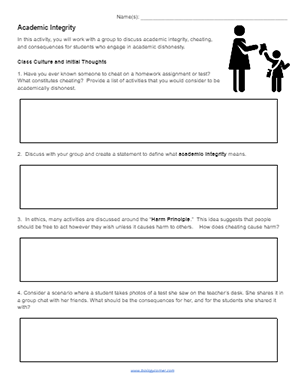
At the beginning of the year, I often discuss with my students what constitutes cheating. I’ve learned that many of my students don’t really have a concrete idea of what constitutes academic dishonesty. Sure, they know they’re not supposed to use their phones during tests to look up answers. They are aware they having someone else write a paper for them is not acceptable. But, do they know that looking up answers on Google can be considered cheating in other ways.
This year, I’m going to spend a little more time discussing academic integrity with my students. I start the activity with a set of questions to answer as a group. Students describe what constitutes cheating, why cheating is harmful, and what “academic integrity” means. They also consider what the consequences should be for someone who cheats.
After a group discussion (about 15 minutes), I give students a handout that outlines examples of academic dishonest.
The list includes:
- Copying someone else’s homework
- Looking at notes during a test
- Passing test information from an earlier class to a later class
- Giving or selling class work to another student
- Texting or other forms of communication during a test
After reviewing this list, students read a set of scenarios and determine if it would constitute cheating. One scenario reads “You are collecting data on photosynthesis with a lab partner and recording results. Your data table has the same values as your lab partner.” Students work together on this section, then we go over each together and discuss why (or why not) it’s cheating.
What About Group Work?
The last section applies mainly to my AP Bio class. Because so many of their projects are collaborations, students are often unclear about what their individual responsibilities are. For example, in this lab on water potential, students collect data together, but write a summary on their own.
I include a list of guidelines on how to complete work in a group. How to discuss and answer questions and when your work should be your own. Students practice these guidelines by reading an abstract from a scientific research article on turtles. There are several questions to answer related to the text. Some are basic reading comprehension questions, like “what do leatherback turtles eat?” Here, it’s expected that they would have the same answers.
The last two questions are summary and opinion questions. Students should realize that these questions require their own thoughts and should not be direct copies from others in their group.

